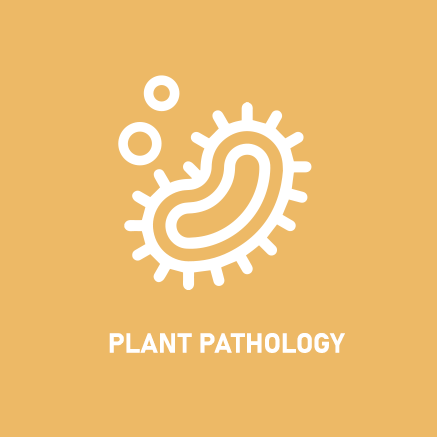Pathophysiology
DEPARTMENT OF PATHOPHYSIOLOGY

Research activities are focused on physiological, biochemical and molecular aspects of microbial plant diseases in order to understand the mechanisms of plant disease resistance and susceptibility. One of the crucial topics is the induction of plant resistance against bacterial, fungal and viral pathogens. Disease resistance can be induced in plants by various pretreatments that do not include direct antimicrobial effects but enhance plant natural resistance against pathogens. Induced resistance was found to be associated with induction of defense-related hormones, changes in cellular redox balance and levels of reactive oxygen species and antioxidants or induction of defense-related enzymes. These studies provide a better understanding of plant defense mechanisms that may lead to the development of new, disease-resistant crop cultivars.
Plants also possess an array of preformed antimicrobial compounds that act directly against pathogens. Numerous antibacterial compounds were isolated from medicinal herbs such as chamomile and identified by chromatography, bioautography and mass spectrometry methods. Biological and molecular characterization of important plant pathogens, such as Xanthomonas campestris pv. vesicatoria, Plum pox virus and new, resistance-breaking strains of Tomato spotted wilt virus is also in focus.
STAFF
RESEARCH
PUBLICATIONS
Selected publications:
Barna B, Fodor J, Harrach BD, Pogány M, Király Z (2012) The Janus face of reactive oxygen species in resistance and susceptibility of plants to necrotrophic and biotrophic pathogens. Plant Physiol Biochem 59: 37-43. doi: 10.1016/j.plaphy.2012.01.014
Pogány M, Dankó T, Kámán-Tóth E, Schwarczinger I, Bozsó Z (2015) Regulatory proteolysis in Arabidopsis-pathogen interactions. Int J Mol Sci 16: 23177-23194. doi:10.3390/ijms161023177.
Burketová L, Trdá L, Ott PG, Valentová O (2015) Bio-based resistance inducers for sustainable plant protection against pathogens. Biotechnol. Adv. 33: 994-1004. doi: 10.1016/j.biotechadv.2015.01.004
Bozsó Z, Ott PG, Kámán-Tóth E, Bognár GF, Pogány M, Szatmári Á (2016) Overlapping yet response-specific transcriptome alterations characterize the nature of tobacco-Pseudomonas syringae interactions. Front Plant Sci 7: 251. doi: 10.3389/fpls.2016.00251
Móricz ÁM, Ott PG, Häbe TT, Darcsi A, Böszörményi A, Alberti Á, Krüzselyi D, Csontos P, Béni Sz, Morlock GE (2016) Effect-Directed Discovery of Bioactive Compounds Followed by Highly Targeted Characterization, Isolation and Identification, Exemplarily Shown for Solidago virgaurea. Anal Chem 88: 8202–8209. doi: 10.1021/acs.analchem.6b02007
Künstler A, Bacsó R, Gullner G, Hafez YM, Király L (2016) Staying alive – is cell death dispensable for plant disease resistance during the hypersensitive response? Physiol Mol Plant Pathol 93: 75-84. doi:10.1016/j.pmpp.2016.01.003
Schwarczinger I, Kolozsváriné Nagy J, Künstler A, Szabó L, Geider K, Király L, Pogány M (2017) Characterization of Myoviridae and Podoviridae family bacteriophages of Erwinia amylovora from Hungary-potential of application in biological control of fire blight. Eur. J. Plant Pathol. 149: 639-652. doi: 10.1007/s10658-017-1214-9
Gullner G, Juhász C, Németh A, Barna B (2017) Reactions of tobacco genotypes with different antioxidant capacities to powdery mildew and Tobacco mosaic virus infections. Plant Physiol. Biochem. 119: 232-239. doi: 10.1016/j.plaphy.2017.09.003
Fodor J, Köblös G, Kákai Á, Kárpáti Z, Molnár BP, Dankó T, Bozsik G, Bognár C, Szőcs G, Fónagy A (2017) Molecular cloning, mRNA expression and biological activity of the pheromone biosynthesis activating neuropeptide (PBAN) from the European corn borer, Ostrinia nubilalis. Insect Molecular Biology 26: 616–632. doi: 10.1111/imb.12324
Móricz ÁM, Szeremeta D, Knaś M, Długosz E, Ott PG, Kowalska T, Sajewicz M (2018) Antibacterial potential of the Cistus incanus L. phenolics as studied with use of thin-layer chromatography combined with direct bioautography and in situ hydrolysis. J. Chromatogr. A 1534:170-178. doi: 10.1016/j.chroma.2017.12.056.











